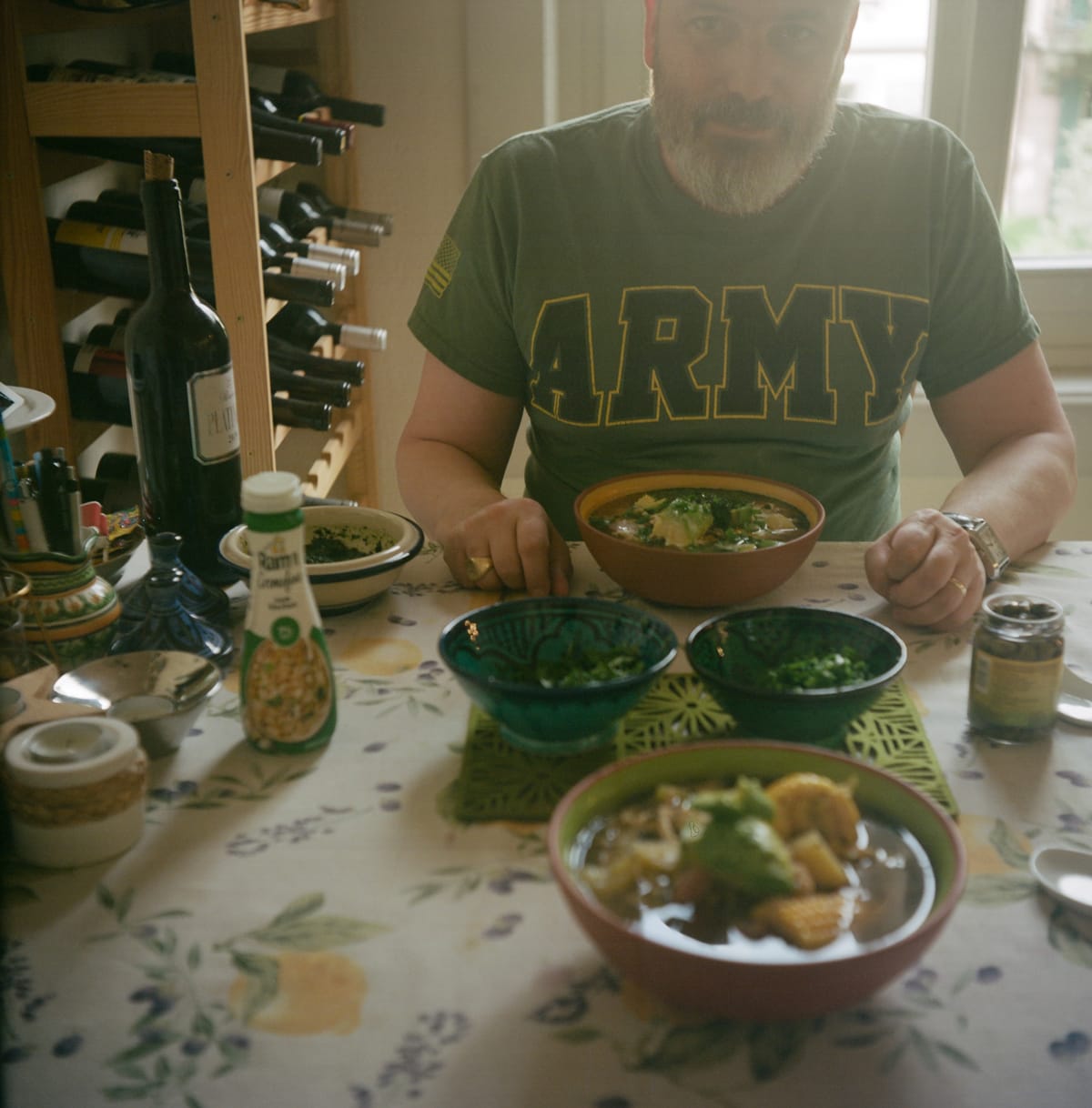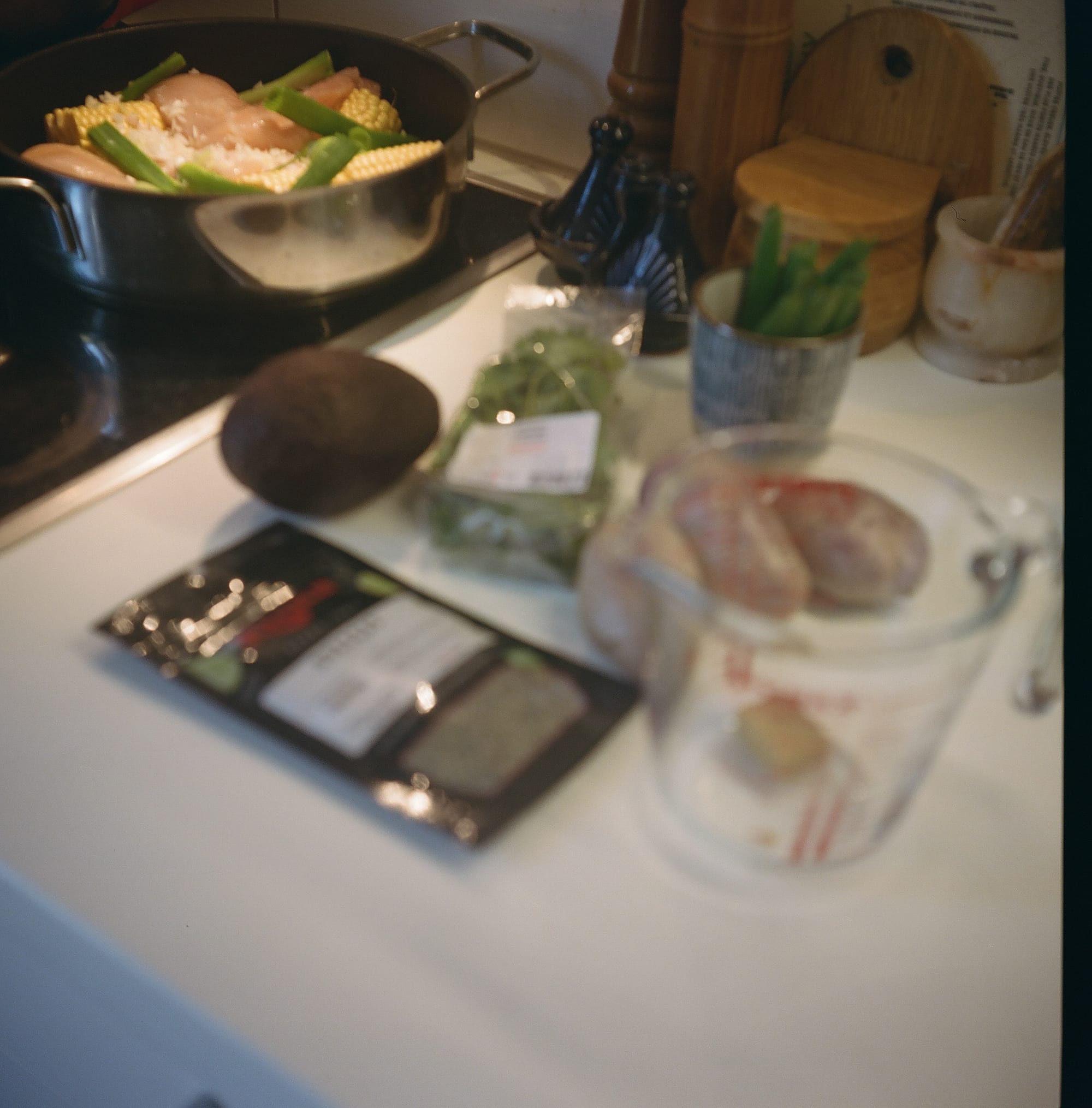What to eat COLOMBIA 🇨🇴 Ajiaco
In Colombia, the dish is usually cooked in clay pots... Ajiaco is as much a national dish for special occasions as it is an occasion for community and gathering in its own right.

Ajiaco
Published June 7, 2024 · by Amanda Rivkin Häsler
Like most dishes from the Americas that have some traceable origin story that pre-dates the arrival of the conquistadores from Spain and elsewhere in Europe, the precise source of ajiaco is subject to debate. One thing is certain though about its modern incarnations: Colombia, Cuba and Peru all have their unique variants which are all called ajiaco.
The Colombian version of ajiaco is made with chicken, three varieties of potatoes that are locally grown, papa criolla, pastusa and sabanero, as well as corn, a herb known as guascas, and is garnished with capers, cream and avocado. It might not sound off the bat delicious, but it is rich, savory and absolutely delightful as a hangover soup. We made it the day after the Eurovision song contest which was more drama than usual this year for reasons.
One variant of the origin story of ajiaco attributes the dish to the Arawakan-speaking Taíno people, a group indigenous to the Caribbean who were some of the first people Christopher Columbus came into contact with upon “discovering” the Americas. However, in Colombia, a few different, competing origins stories are offered.
The Muisca people of Colombia who inhabited the plateau around modern day Bogotá are credited with having crafted a dish that could be described as a proto-ajiaco consisting of potatoes and herbs. Colombian historians also cite the indigenous Chibcha people of the same area known as Cundinamarca as a possible originator of the dish that came to be known as ajiaco. The Chibcha ate a soup with a milky corn base and potatoes.
In this history, Spaniards are credited with bringing the additions of chicken and cream to the soup bowl. By the 19th century, the inclusion of chicken in any dish was already considered posh in the Colombian capital and to offer it in a dish to guests was a surefire symbol of wealth and status. While the dish is popular across all social strata, the poorer traditionally settled for a version without meat and more vegetables.
Within Colombia itself, there are more than 100 types of potatoes yielding a hefty export crop of about 800 metric tons of frozen potatoes. The Incas are credited with first cultivating the potato nearly two millennia ago. It was not until recent centuries that Europe experienced the savory greatness of this new work vegetable.

The other unique element in ajiaco is this herb known as guascas, which can be found in stews and a variety of Colombia dishes and was originally used in Andean medicine. In the US, it is a weed known as “gallant soldier,” but in Switzerland we found it at the mini market next to the Bolivian spot we visited in Geneva near the main rail station.
Guascas lend a fragrant but slightly unusual and muted fragrance to the dish that could be substituted with mint and cilantro combined with a bit of thyme in a pinch, though it is not the same. It is also available online. Guascas definitely have their own flavor that is hard to replace.
In Colombia, the dish is usually cooked in clay pots and there are two different noteworthy types of ajiaco: ajiaco bogotano and ajiaco santafereño. Ajiaco is as much a national dish for special occasions as it is an occasion for community and gathering in its own right. The meticulous preparation brings people together, as do the exchange of toppings placed in the middle.
Overall, it is a wonderful dish and there is probably not a Colombian alive who will not think of their ancestors, especially grandma, when recalling it. Perfect for large gatherings and nice after a night of drinking too, this staple is not perfectly faithful to the Colombian original given the varieties of potatoes on offer there that are incomparable to the kinds that have traversed back across the pond to the European side of the Atlantic. Avocado brings a freshness to the dish which is complimented by the unexpected brininess of the capers.
Recipe
Ingredients:
2 skinless boneless chicken breasts
2 ears of corn
2 shallots (or 4 cloves of garlic)
5 white potatoes
3 scallions
2 chicken bouillon cubes
3 red potatoes
10 grams of guascas
1 avocado
2 tablespoons of capers
20 grams of cilantro
Cream
Step 1: Place the chicken breasts and ears of corn cut into thirds in a pan. Add diced shallots, five white potatoes peeled and chopped into small pieces and three scallions, with the bulb part finely diced, the rest chopped in large pieces, and the green part at the ends set aside for garnish after soup is done.
Step 2: Boil water and add bouillon cubes to approximately 1.5 liters of water, enough to cover the ingredients in the pot. Add to the pot and allow to boil. Once water is boiling, turn to a low heat and cover for approximately 30-45 minutes.
Step 3: After approximately half an hour, remove the chicken breasts and allow to cool. Add chopped red potatoes and the guascas. Cover and cook for 15-20 more minutes.
Step 4: Once chicken cools, shred and return to pan. Remove long stalks of scallions from the broth.
Step 5: Serve with avocado, capers, cilantro and cream on top, or provide (as we did) a modest buffet of toppings for you and your guests to choose from at will.
Tips, tricks and notes:
Guascas can be found online or at the small grocery Rouge et Blanc at Rue de la Servette 13 in Geneva, located next to Willy’s Restaurant Bolivien, where we had a previous Swiss Global Dining excursion for Bolivian cuisine as well as breakfast the morning after we visited Restaurant Le Luserna. For some reason, this small grocery seems to have ingredients from the region that are even hard to locate in bigger ethnic groceries in Geneva.
Finding varieties of potatoes in Switzerland to rival the multitude available in the Americas is impossible, but we settled for two, rather than three kinds of potatoes. We apologize to all Colombian and ajiaco purists but substitutions are the name of the game when necessary, and when and where possible, we do try and make note of it.
Learn where to eat Colombian food in Switzerland.
Follow our social media pages @swissglobaldining on Instagram, TikTok and YouTube